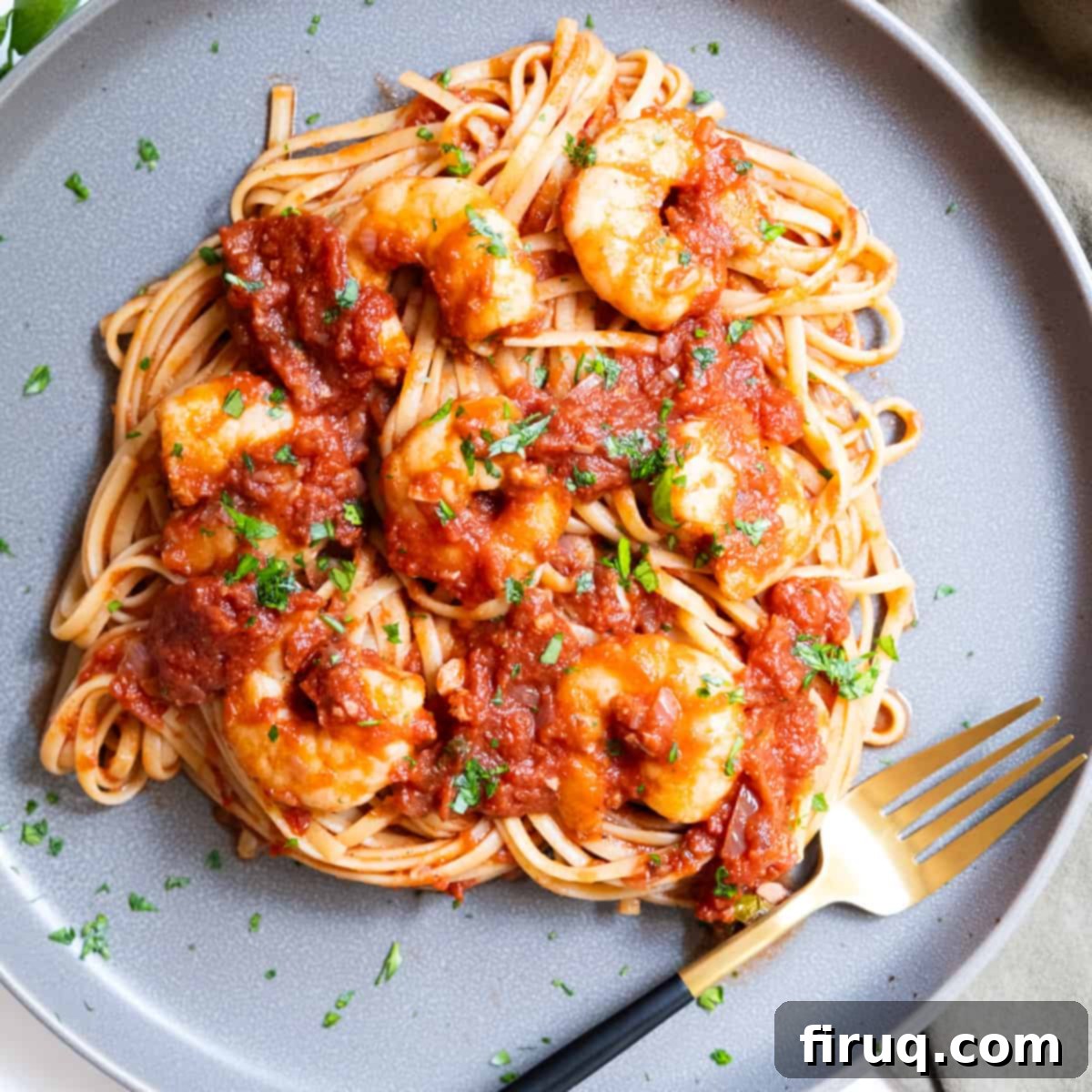Fiery Shrimp Fra Diavolo with Linguine: An Authentic Italian Spicy Seafood Pasta Recipe
Shrimp Fra Diavolo with linguine is a truly iconic Italian dish, beloved for its vibrant flavors and satisfying heat. This recipe isn’t just for special occasions; it’s a versatile culinary delight perfect for Christmas Eve’s traditional Feast of the Seven Fishes, a comforting Friday night meal during Lent, or simply a quick and exciting summer pasta that brings a delightful kick to your table. My passion for spicy shrimp pasta runs deep, and this particular dish delivers an incredible depth of flavor alongside a stimulating, yet not overwhelming, burst of spice – making it an ideal choice for the entire family to enjoy.
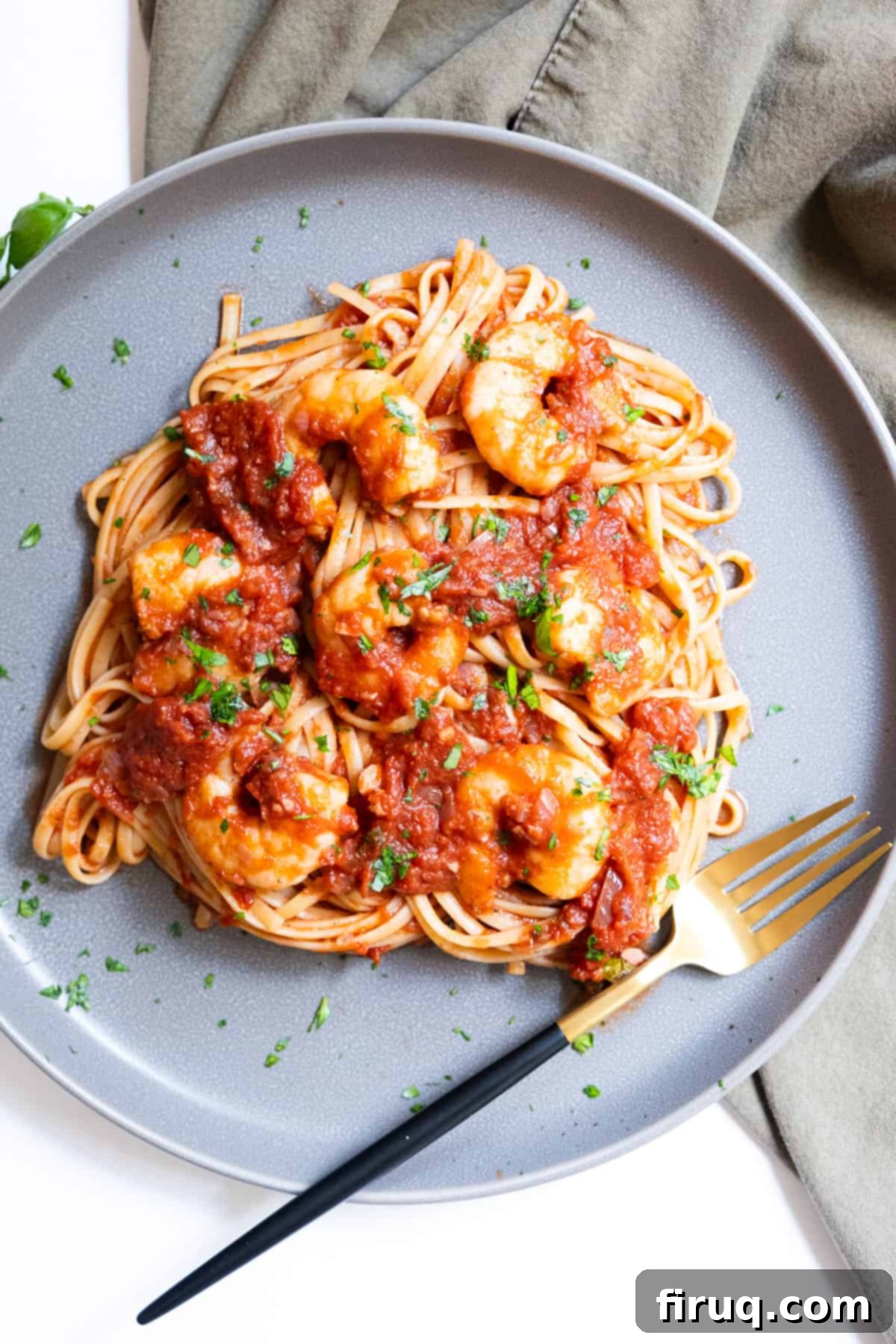
If you’re a fan of spicy pasta dishes, be sure to explore some of our other fiery favorites like Spicy Chicken Riggies, Spicy Vodka Sauce, or Bucatini Amatriciana.
[feast_advanced_jump_to]
What Does “Fra Diavolo” Mean? Unpacking the Fiery Name
The name “Fra Diavolo” directly translates from Italian to “Brother Devil,” a moniker that perfectly captures the characteristic spiciness of this iconic dish. While it’s commonly misspelled as “Diablo” in English – perhaps due to the Spanish word for devil – the original Italian term carries a rich history and a hint of intriguing folklore.
The phrase’s history is quite fascinating, with roots tracing back to the French occupation of Italy. Michele Pezza, an Italian insurgent leader, earned the nickname “Fra Diavolo” for his audacious and rebellious spirit. He led a resistance movement, much like a “brother devil” stirring up trouble. While this historical figure is famous, it’s worth noting that the culinary origin of this specific fiery tomato sauce is far more debated.
As with many beloved Italian dishes, the exact birthplace of Fra Diavolo sauce is a subject of contention. Some culinary historians believe it originated in the vibrant region of Naples, known for its bold flavors and fresh seafood. Others argue that it was actually created in the Italian-American communities of the tri-state area of the United States, where Italian immigrants adapted traditional recipes with local ingredients and a penchant for robust tastes. However, my perspective on such debates is simple: who truly cares about the precise origin when the result is so undeniably delicious? Whether it was born on the shores of Italy or in an American kitchen, its irresistible flavor makes it a fantastic pairing, whether it’s served with this sumptuous shrimp pasta or in a hearty Mussels Fra Diavolo dish!
The “devil” in Fra Diavolo isn’t just a name; it describes the thrilling heat that distinguishes this sauce. It’s a robust tomato base infused with a generous amount of chili peppers, creating a captivating warmth that dances on the palate. This isn’t a sauce that burns you out; rather, it’s a dynamic and flavorful spice that makes every bite exciting, transforming simple seafood and pasta into an unforgettable meal.
Essential Ingredient Notes and Flavorful Substitutions
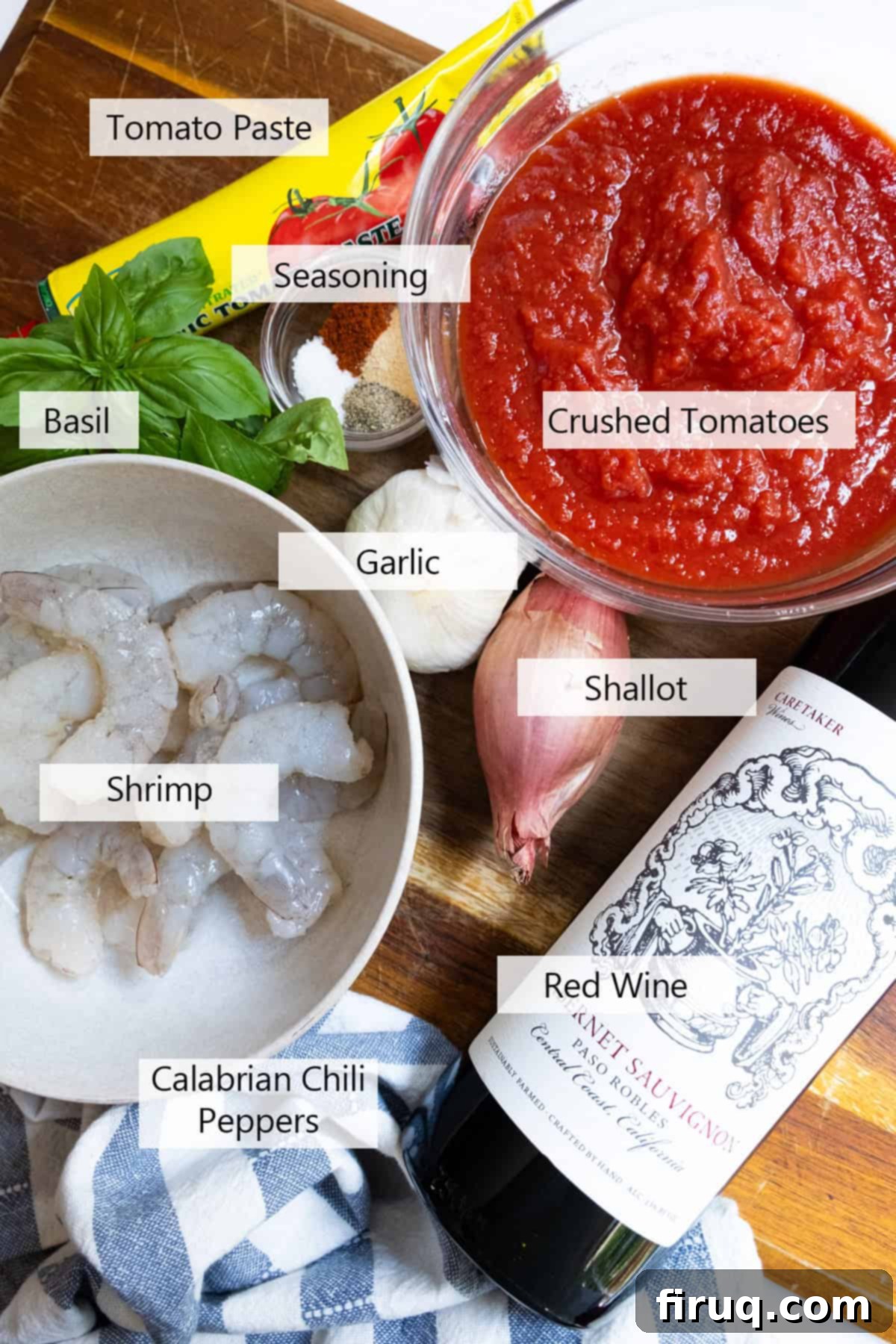
- Shrimp: For the most exceptional flavor, always opt for raw shrimp in this recipe. Cooking the shrimp directly in the same pan used for the sauce is crucial. This step allows the rich flavors released from the shrimp during searing to become the foundation of your Fra Diavolo sauce, infusing it with that essential seafood essence from start to finish. Fresh shrimp are always preferred, but high-quality frozen raw shrimp (thawed and patted dry) can also work wonders.
- Linguine: Linguine is my top choice for seafood pasta due to its flat, ribbon-like shape, which effortlessly cradles and picks up a generous amount of sauce in every bite. If linguine isn’t available, excellent substitutes include bucatini (a hollow spaghetti that captures sauce beautifully), delicate angel hair, or classic spaghetti. Each of these pasta shapes will provide a satisfying texture and sauce adherence.
- Red Wine: My golden rule for cooking with wine is simple: if you wouldn’t drink it, don’t cook with it! A good quality dry red wine will significantly enhance the depth and complexity of your sauce. I recommend using a robust Cabernet Sauvignon, a fruity Malbec, or a smooth Merlot. The wine adds a rich, acidic backbone that balances the tomatoes and chilis beautifully, creating a more sophisticated flavor profile.
- Calabrian Chili Peppers: These vibrant, spicy peppers are the heart and soul of Fra Diavolo’s distinctive heat. I typically purchase them jarred, finely chopped, and packed in oil, which adds both heat and a wonderful savory note. You can also use fresh or dried chili peppers if preferred. For those who can’t find Calabrian chilies, a good quality crushed red pepper is a suitable substitute, though it will offer a slightly different flavor profile. If you’re seeking a milder red sauce with seafood, our Linguine with Red Clam Sauce offers a delicious, less fiery alternative.
- Tomatoes: Crushed tomatoes form the robust base of this sauce. Using high-quality canned crushed tomatoes makes a significant difference. San Marzano tomatoes, known for their sweet, balanced flavor, are always an excellent choice if available. The simmering process truly develops their flavor, transforming them from raw to wonderfully rich.
- Aromatics (Shallots & Garlic): These unsung heroes provide the foundational flavor. Shallots offer a milder, sweeter onion flavor than regular onions, while fresh garlic is indispensable for that authentic Italian taste. Always mince your garlic fresh for the best aroma and flavor.
- Herbs & Seasoning (Basil, Salt, Pepper, Cayenne Pepper): Fresh basil is key for brightness. Don’t skimp on salt and black pepper; they bring out all the other flavors. Cayenne pepper adds an extra layer of heat to complement the Calabrian chilies, allowing you to fine-tune the spice level to your preference.
- Extra Virgin Olive Oil (EVOO): A good quality EVOO is essential for sautéing and building the initial flavor layers of the sauce. Its rich, fruity notes marry well with the other ingredients.
*Please see the recipe card below for specific measurements and detailed information on all ingredients.
Crafting the Perfect Fiery Shrimp Fra Diavolo: A Step-by-Step Guide
This recipe is surprisingly straightforward, delivering an exceptional depth of flavor and that signature spicy kick without unnecessary complexity. Follow these easy steps to create a show-stopping Fra Diavolo.
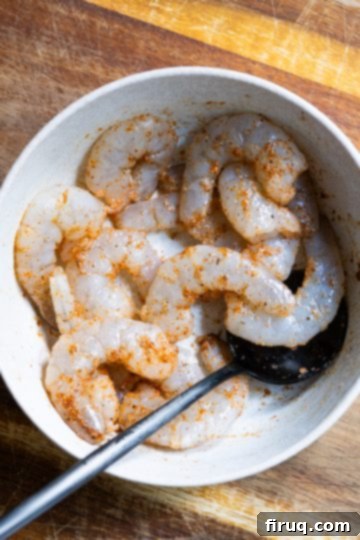
Step 1: Prepare and Marinate the Shrimp. Begin by peeling, deveining, and removing the tails from your raw shrimp. This ensures a clean and enjoyable eating experience. Crucially, dry the shrimp thoroughly with a paper towel. This step prevents them from steaming and helps achieve a beautiful sear. Place the dried shrimp in a bowl and coat them generously with 2 tablespoons of extra virgin olive oil, garlic powder, 1 teaspoon salt, 1 teaspoon black pepper, and 1 teaspoon of cayenne pepper. Allow them to marinate for at least an hour in the refrigerator to infuse maximum flavor.
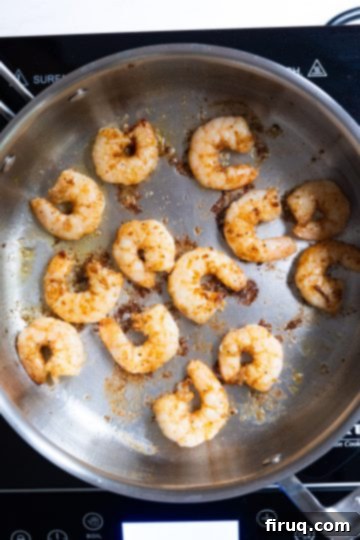
Step 2: Sear the Shrimp to Perfection. In a large saucepan (the same one you’ll use for the sauce to capture all those delicious drippings!), heat 1 tablespoon of olive oil over medium-high heat until shimmering. Once hot, fry your seasoned shrimp in batches, being careful not to overcrowd the pan. This allows for proper searing rather than boiling. Cook the shrimp for approximately 60-90 seconds per side, just until they turn opaque and pink. Overcooked shrimp will begin to shrivel and curl tightly, with their heads touching their tails, so watch them closely! Once cooked, remove the shrimp and set them aside for later, along with any juices that accumulated in the bowl.
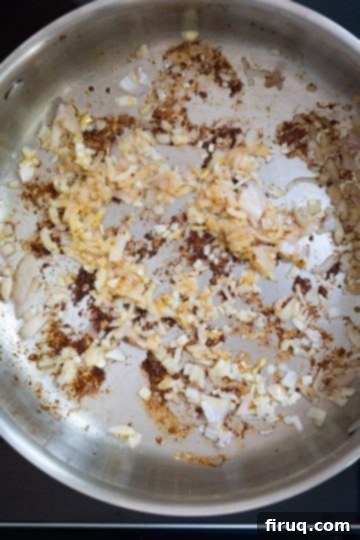
Step 3: Build the Aromatic Base. Using the same pan, reduce the heat to medium and add another tablespoon of olive oil. Add the chopped shallots and sauté for 3-4 minutes, stirring frequently to prevent burning, until they become soft and translucent. This gentle cooking extracts their sweet essence. Then, add the minced garlic and sauté for just 30 seconds until fragrant; be careful not to burn it, as burnt garlic can turn bitter.
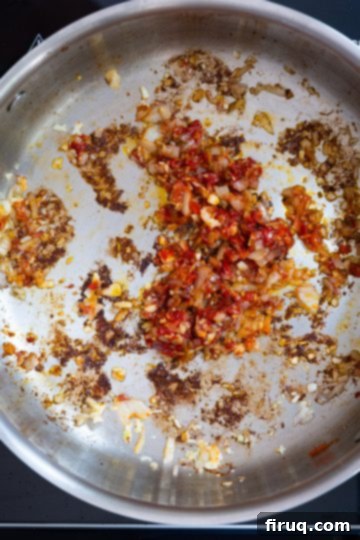
Step 4: Introduce the Heat and Depth. Next, add the pungent Calabrian chili peppers and concentrated tomato paste to the pan. Stir continuously and allow the tomato paste to caramelize for about 2 minutes. This crucial step deepens the color and flavor of the sauce, transforming the bright tomato paste into a rich, complex foundation. The heat from the chili peppers will also begin to bloom at this stage, setting the “devilish” tone for the sauce.
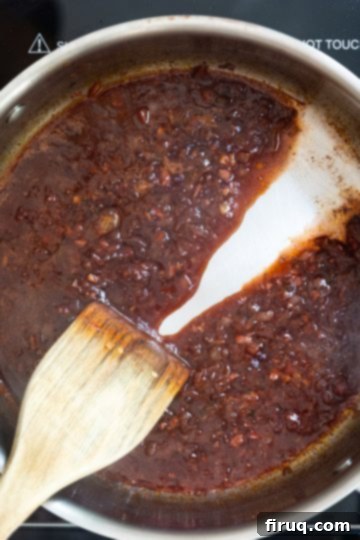
Step 5: Deglaze and Reduce the Red Wine. Pour in the red wine to deglaze the pan. Using a wooden spoon, vigorously scrape up all the flavorful brown bits (fond) stuck to the bottom of the pan. These bits are packed with concentrated flavor from the shrimp and aromatics. Bring the wine to a gentle simmer and let it reduce for about 5 minutes, or until its volume is cut by half. The red wine reduction will noticeably thicken; you’ll know it’s ready when you can drag your spoon through it and it leaves a clear trail behind before slowly coming back together.
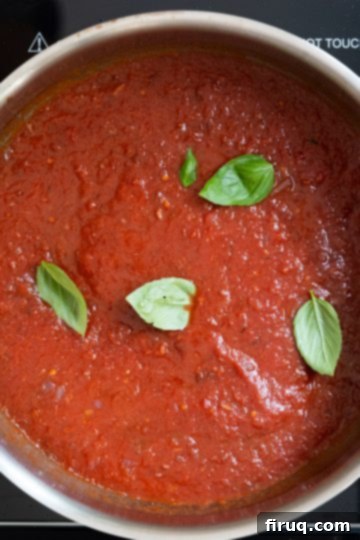
Step 6: Simmer the Sauce for Deep Flavor. Add the crushed tomatoes, fresh basil leaves, and 2 teaspoons of salt to the pan. Stir everything together until well combined. Bring the sauce to a gentle simmer and allow it to cook for at least 30 minutes, stirring occasionally. This extended simmering time is essential for the raw flavors of the canned tomatoes to mellow and meld with the other ingredients, developing a rich, sweet, and deeply satisfying tomato sauce. The longer it simmers, the more complex the flavors become.
Step 7: Cook the Linguine to Al Dente. While your sauce is simmering, bring a large pot of heavily salted water to a rolling boil. Add your linguine to the boiling water when the sauce has been simmering for approximately 20 minutes, allowing them to finish cooking around the same time. Cook the pasta according to package directions until it is perfectly al dente – firm to the bite, yet cooked through. Remember to reserve about 1 cup of the starchy pasta water before draining.
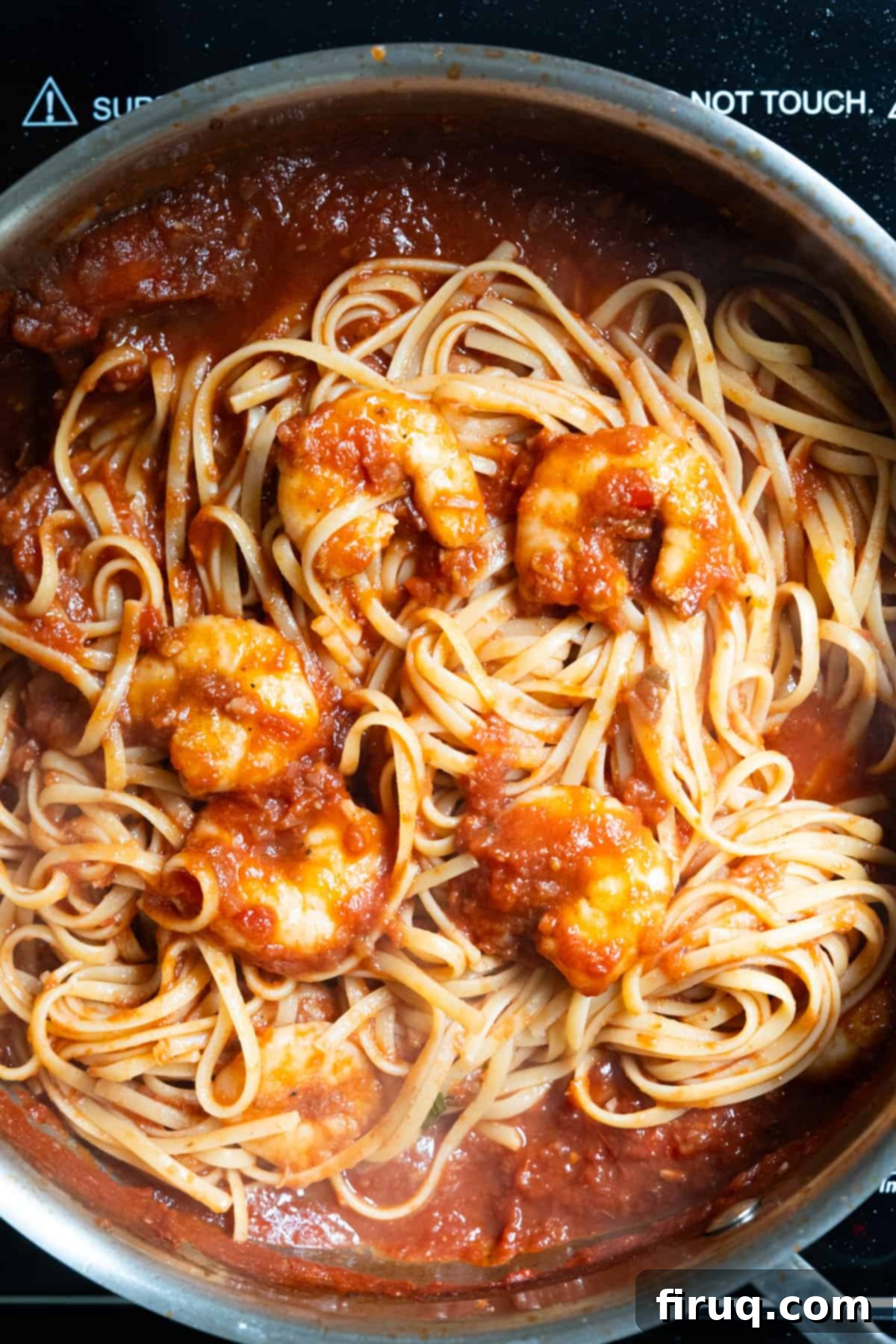
Step 8: Combine and Serve. Gently stir your cooked shrimp and any accumulated juices back into the simmering Fra Diavolo sauce. The juices are pure flavor and should not be discarded! Add about 1 cup of the reserved pasta water to the sauce; the starch in the water helps to emulsify the sauce, making it incredibly silky and allowing it to cling beautifully to the linguine. Drain the linguine and add it directly to the sauce in the pan. Toss everything together until the pasta is thoroughly coated. Finish with a generous sprinkle of freshly chopped parsley and extra basil for a burst of freshness. Serve immediately with a crusty loaf of Italian bread to sop up every last drop of that amazing sauce.
Shrimp Fra Diavolo with Linguine is an exquisite dish, perfect for serving on special occasions like Our Feast of Seven Fishes Menu for Christmas Eve. It pairs wonderfully with other seafood delights such as Italian Stuffed Baked Clams and Steamed Mussels in White Wine, creating a truly memorable culinary experience.
Pro Tips for a Perfect Fra Diavolo
- Always Dry Your Shrimp: This cannot be stressed enough! Before adding any oil or seasoning, press your shrimp thoroughly with paper towels to remove excess moisture. If they’re wet, they’ll “boil” instead of searing, resulting in rubbery texture and less flavor. It’s a common mistake that makes a huge difference in the final dish!
- One Pan, Maximum Flavor: The secret to a truly flavorful sauce is to cook it in the same pot where you seared the shrimp. All those beautiful brown bits (fond) stuck to the bottom of the pan are packed with umami. Deglazing the pan with red wine will release these flavors directly into your sauce, creating incredible depth.
- Master the Red Wine Reduction: Be patient during the red wine reduction step. It’s a key flavor builder. The goal is to cook off the alcohol and concentrate the wine’s essence. You’ll know it’s ready when the liquid visibly thickens and when you drag a wooden spoon through it, it leaves a clear trail for a moment before the liquid slowly fills it back in. Watch the video above for a visual demonstration!
- Choose Your Wine Wisely: When cooking with red wine for a savory sauce like this, I typically use a dry, medium-bodied Cabernet Sauvignon. Malbec or Merlot are also excellent choices, lending their robust fruit notes without overpowering the seafood.
- Simmer for Depth: Don’t rush the sauce. The 30-minute simmering period for the tomatoes is vital. This allows the raw acidity of the canned tomatoes to mellow and deepen into a rich, sweet, and complex flavor profile that is characteristic of authentic Italian sauces.
- Reserve Pasta Water: Always save at least a cup of your starchy pasta water. This “liquid gold” is crucial for creating a silky, emulsified sauce that perfectly coats your linguine. It helps bind the sauce to the pasta, ensuring every bite is bursting with flavor.
- Adjust Spice to Taste: The amount of Calabrian chili peppers and cayenne can be adjusted to your family’s preference. Start with the recommended amount and add more gradually if you prefer a spicier kick. You can always add more heat, but you can’t take it away!
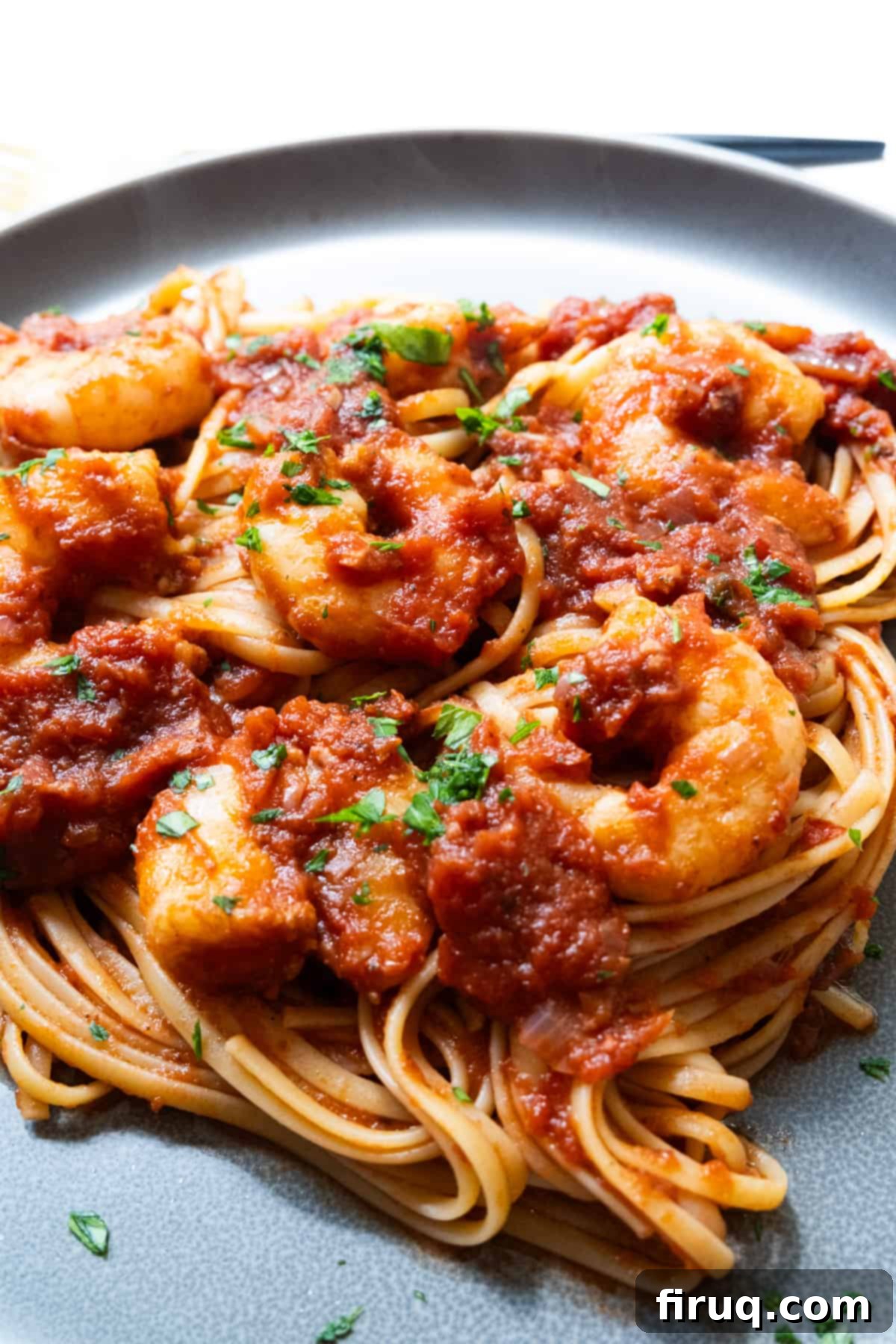
Common Questions About Shrimp Fra Diavolo
While both Arrabiata and Fra Diavolo are spicy Italian tomato sauces, there are key distinctions. Fra Diavolo traditionally features seafood, often with its cooking juices incorporated into the sauce for a richer, more complex flavor profile. Arrabiata, meaning “angry” in Italian, is more of a spicy marinara, typically served without seafood and focusing on a pure, fiery tomato taste. I also find that Fra Diavolo often has a slightly chunkier texture, especially when made with crushed tomatoes, while Arrabiata tends to be smoother.
For any tomato-based sauce, especially one using canned tomatoes, a minimum simmering time of 25-30 minutes is crucial. Canned tomatoes, though preserved, are essentially raw and can taste acidic if not cooked long enough. This simmering period allows the flavors to meld, the acidity to mellow, and the sauce to develop a sweet, rich, and deeply savory taste. The longer it simmers, up to an hour, the more profound the flavor becomes.
Fra Diavolo is incredibly versatile and pairs beautifully with a variety of seafood. While mussels are a classic choice and highly recommended, shrimp (as in this recipe) is another fantastic option due to its quick cooking time and sweet flavor. Other excellent choices include calamari, tender lobster, or succulent crab. For an impressive mixed seafood Fra Diavolo, you could even combine several of these, allowing each to impart its unique flavor to the spicy tomato sauce.
Absolutely! The spice level is entirely customizable. To make it milder, reduce the amount of Calabrian chili peppers or crushed red pepper. You can start with just a teaspoon and taste the sauce, adding more gradually until it reaches your desired heat level. Another option is to use a less potent chili, like a mild red pepper flake, or even omit the cayenne pepper entirely.
Yes, you can certainly use frozen raw shrimp. The key is to thaw them properly and, most importantly, pat them extremely dry with paper towels before marinating and searing. Excess moisture will prevent them from browning and give them a rubbery texture. Thaw them overnight in the refrigerator or under cold running water in a colander.
Discover More Irresistible Pasta Dishes
- Linguine with Clams
- Linguine with Red Clam Sauce
- Lemon Pesto Spaghetti with Scallops
- Shrimp Scampi Without Wine
If you loved this Shrimp Fra Diavolo recipe, we would be thrilled if you shared it with your friends and family! You can find us on Instagram @vindelgiudice and @alwaysfromscratch on TikTok. Please take a moment to leave a rating below and let us know what you think. Don’t forget to explore these other fantastic seafood pasta recipes for more culinary inspiration!
📖 Recipe
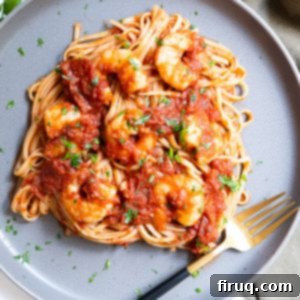
Shrimp Fra Diavolo with Linguine
Vincent DelGiudice
Pin Recipe
Equipment
-
1 large saucepan
-
1 large pot
Ingredients
- 1 lb linguine
- 2 shallots (chopped)
- 4 Cloves garlic (minced)
- 1 24 oz can crushed tomatoes
- 2 tablespoon tomato paste
- 4 basil leaves
- 1 lb shrimp
- 4 tbsp EVOO
- 1 cup red wine
- 1-2 tablespoon calabrian chili peppers
- 3 teaspoon salt
- 1 teaspoon black pepper
- 1 tsp cayenne pepper
Instructions
-
Defrost shrimp if frozen, then peel and devein them thoroughly. Pat the shrimp completely dry with a paper towel. In a bowl, marinate the shrimp for 1 hour in the refrigerator with 2 tablespoons EVOO, 3 cloves minced garlic, 1 teaspoon salt, 1 teaspoon black pepper, and 1-2 teaspoons of cayenne pepper (adjust to your spice preference).
-
In a large saucepan over medium-high heat, add 1 tablespoon of EVOO. Once hot, pan-fry the marinated shrimp in batches to prevent overcrowding. Cook for 1-2 minutes per side until opaque and pink. Remove shrimp and set aside to avoid overcooking.
-
In the same pan, lower the heat to medium. Add 1 tablespoon of EVOO and sauté the chopped shallots for 3-4 minutes until translucent. Stir in the remaining minced garlic, Calabrian peppers, and tomato paste. Continue to sauté and caramelize the tomato paste for about 2 minutes, stirring constantly.
-
Pour in the red wine to deglaze the pan, using a wooden spoon to scrape all the flavorful brown bits from the bottom. Simmer the wine for about 5 minutes until it reduces by half and thickens enough to leave a trail when a spoon is dragged through it.
-
Stir in the crushed tomatoes, fresh basil leaves, and 2 teaspoons of salt. Bring the sauce to a gentle simmer and let it cook for 30 minutes, stirring occasionally, to develop deep flavors.
-
While the sauce simmers, bring a large pot of heavily salted water to a boil. Add the linguine and cook until al dente. Reserve about 1 cup of pasta water before draining the linguine. Slowly add the reserved pasta water to your simmering sauce, as needed, to achieve a desirable consistency.
-
Add the cooked shrimp (and any juices from the bowl) to the Fra Diavolo sauce and mix gently. Then, add the drained linguine to the pan and toss everything together until the pasta is evenly coated. Garnish with freshly chopped parsley and extra basil, then serve immediately with crusty bread.
Notes
- Dry your shrimp! This is the most important step for getting a beautiful sear and preventing rubbery texture.
- Marinating the shrimp for an hour in the fridge infuses them with much more flavor.
- Red wine reduction is simpler than it sounds. Just let it simmer patiently, and you’ll know it’s ready when a spoon leaves a slow-filling trail. Refer to the blog images for a visual guide.
- Always save some pasta water! The starch in the water helps the sauce emulsify and adhere wonderfully to the linguine, making for a richer, more cohesive dish.
Nutrition
Tried this recipe?We’d love for you to Leave a Review!
